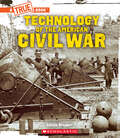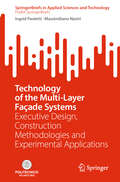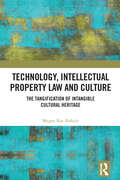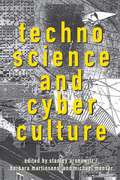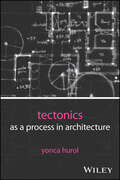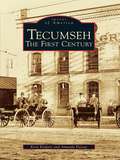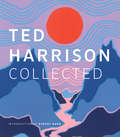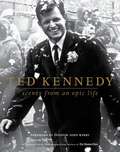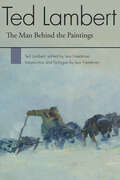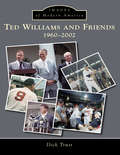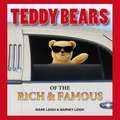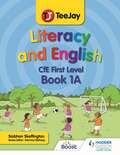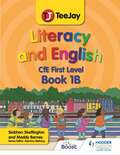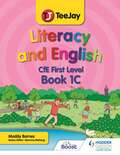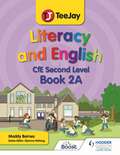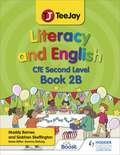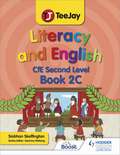- Table View
- List View
Technology of the American Civil War (A True Book)
by Felicia BrowerHow did advancements in technology influence the outcome of the American Civil War? Discover it with this book for young readers.Photography, railroads, telegraphs, advanced weaponry . . . many of these technologies existed before the Civil War, but their use in the conflict played a huge role in changing the course of history. Some other advances, like the medical treatment given to wounded soldiers, were developed during the war. Learn about all the methods and machines that turned the tide of history in Technology of the American Civil War.ABOUT THIS SERIES:The Civil War took place in America between April 1861 and April 1865. During the four-year struggle between the North and the South, approximately 10,000 battles were fought on land and sea, leaving 620,000 dead. As a result of the war, more than three million enslaved people gained their freedom. The four books in the "Exploring the Civil War" series examine the war's key people, places, and events, and its causes and consequences, making them the perfect tools to introduce children to one of the defining events in American history.
Technology of the Multi-Layer Façade Systems: Executive Design, Construction Methodologies and Experimental Applications (SpringerBriefs in Applied Sciences and Technology)
by Ingrid Paoletti Massimiliano NastriThe book explores the design, production and construction processes of the multi-layer façade systems towards the principles of environmental and energy sustainability through the drafting of an explanatory and operative reference instrument. The work provides the planning of a technical guide, focusing on the executive design and construction methodologies. The scientific basis of the research implies the definition of the main functional typologies, established on the analysis conducted on the experimental case studies, with the aim of achieving a codification of the performance and executive potentialities. The development of the book as a technical guide on the multi-layer façade systems involves the possibilities of technology transfer towards different building types and intended uses, with the aim of increasing hygro-thermal, lighting and acoustic performance through the application of technical skins, devices and integrated screens on the external enclosures. Moreover, the book explains the modes of technology transfer through the use of standard and non-customized products, so as to improve the diffusion in the production and construction of mass-produced systems and components.
Technology, Intellectual Property Law and Culture: The Tangification of Intangible Cultural Heritage
by Megan Rae BlakelyFocusing on cultural expressions that are most likely to intermingle with copyright law, trademark and IP-adjacent regulations, this book examines contemporary issues in technology, intellectual property law, and culture.Intangible Cultural Heritage can consist of traditional knowledge, songs, craftsmanship, dance, and other practices, as well as the associated cultural artefacts and spaces; a widely varied global living heritage, transmitted generationally, must be allowed to organically evolve, often defying the process of identification so desirable in the realm of legal protections. This nebulous essence is particularly ill-suited to modern legal frameworks that can conflate the creative outputs that copyright is meant to protect with shared cultural practices. Combining a legal perspective with historical tact, the book develops a theoretical model to track the interaction amongst these issues as well as to make policy recommendations based on the existing and projected possible future outcomes. Several chapters of the book will be dedicated to contemporary issues where this framework and interaction are currently developing, focussing on law and technology issues with archiving and museums, online platforms and copyright infringement, and communities and creative production in virtual worlds.The book will be of interest to students and scholars in the field of copyright law and intellectual property law.
Technology, Monstrosity, and Reproduction in Twenty-First Century Horror
by Kimberly JacksonThrough a wide spectrum of horror sub-genres, this book examines how the current state of horror reflects the anxieties in Western culture. Horror films bring them to a mass audience and offer new figures for the nameless faceless 'antagonist' that plagues us and provides material with which to build a different understanding of ourselves.
Technology-Enabled Innovations in Education: Select Proceedings of CIIE 2020 (Transactions on Computer Systems and Networks)
by Samira Hosseini Diego Hernan Peluffo Julius Nganji Arturo Arrona-PalaciosThis book contains peer-reviewed selected papers of the 7th International Conference on Educational Innovation (CIIE 2020). It presents excellent educational practices and technologies complemented by various innovative approaches that enhance educational outcomes. In line with the Sustainable Development Goal 4 of UNESCO in the 2030 agenda, CIIE 2020 has attempted to “ensure inclusive and equitable quality education and promote lifelong learning opportunities for all.” The CIIE 2020 proceeding offers diverse dissemination of innovations, knowledge, and lessons learned to familiarize readership with new pedagogical-oriented, technology-driven educational strategies along with their applications to emphasize their impact on a large spectrum of stakeholders including students, teachers and professors, administrators, policymakers, entrepreneurs, governments, international organizations, and NGOs.
Technoscience and Cyberculture: A Cultural Study
by Stanley Rronowitz, Barbara Martinsons, and Michael Menser with Jennifer RichTechnoculture is culture--such is the proposition posited in Technoscience and Cyberculture, arguing that technology's permeation of the cultural landscape has so irrevocably reconstituted this terrain that technology emerges as the dominant discourse in politics, medicine and everyday life. The problems addressed in Technoscience and Cyberculture concern the ways in which technology and science relate to one another and organize, orient and effect the landscape and inhabitants of contemporary culture.
Tectonics as a Process in Architecture
by Yonca HurolDetailed, research-based review of the intersection of building processes and tectonics, with case studies and theoretical reflections Tectonics as a Process in Architecture explores the dynamic nature of building processes and their impact on architectural tectonics. Detailed case studies and theoretical reflections are included to help readers see how recognizing tectonics as a process can be beneficial. The book is based on research that was conducted to document all changes during the building processes of a house through close engagement between the researcher and the building; the researcher was also the building’s owner, a neighbor to it, its architect, and a construction control. This close connection enabled the capture of numerous changes, some resulting in tectonic affects, while others reflected innovative approaches. These changes were introduced by various actors in the process including contractors, builders, and foremen. In Tectonics as a Process in Architecture, readers will find: Invaluable insights on why tectonics is not merely as an outcome but an inclusive, collaborative process that enhances architectural qualityTwo process maps, one for tectonic affects and one for innovative approachesEvolving changes during construction and their potential to foster innovationA theory on procedural and inclusive tectonics, primarily focused on details Due to its multifaceted nature, Tectonics as a Process in Architecture will appeal to academics, students, and professionals interested in the intersection of architectural, engineering, construction and tectonic principles.
Tecumseh: The First Century
by Amanda Payeur Kern KuipersTecumseh was founded by a family of pioneers. The principals in the venture were Musgrove Evans with his wife, Abi Evans (n©e Brown), Abi's brother, Joseph Brown, and Austin E. Wing, a cousin of the Brown family. Joseph and Abi had firsthand knowledge of pioneer life, having established Brownville in Jefferson County, New York, with their father, Jacob Brown. Austin E. Wing was already in Michigan, living in Monroe, and he convinced Musgrove that the new settlement would be a noble and profitable venture. Musgrove convinced his brother-in-law, Joseph, and the three formed a company with the purpose of purchasing land and founding a community in the interior of Michigan. Upon arrival, a number of the first settlers were taking lunch while building the first structure, a 20-by-20 footlog "company house" to be shared by all until they could each build their own houses , and Musgrove Evans suggested naming the town after the Shawnee chief Tecumseh. There was some debate, especially as Tecumseh had fought on the side of the British, but it was decided that he had truly fought for his convictions and for his people, so the name was decided upon.
Ted Harrison Collected
by Robert BuddCelebrating beloved Canadian artists, the Collected series is beautifully designed with an affordable format, ideal for gift buyers and visitors. Canadian artist Ted Harrison began to paint as a young boy in school, and in the years since, has both worked and taught as an artist, an illustrator, and an author. The artist's move to the Yukon in the 1960s opened up his style to the breathtaking artistic interpretations of sea, land, and sky that he is so famous for today. Sweeping lines and broad swatches of color are iconic in Harrison's paintings, and this collection showcases the multitudes of subjects and settings that he depicts using that signature style.Pairing bold, whimsical colors with sophisticated depictions of life, culture, and the people who live in the wintery North, Ted Harrison's paintings have a time-tested value and charm that appeals to all ages. This volume is a compendium of some of Harrison's best and most memorable works. With an introductory essay by author Robert Budd, this collection is a tribute to one of Canada's most-loved artists.
Ted Kennedy
by Boston GlobeThe extraordinary life of senator Edward Moore Kennedy captures two vivid stories: one is of an iconic senator who experienced the greatest of triumphs and the most devastating of losses, and the other is a chronicle of the most dramatic moments in our recent American history, including the assassination of a president and the struggle for civil rights. Through more than two hundred stunning black-and-white photographs pulled from the pages of The Boston Globe and its extensive archives, Ted Kennedy: Scenes from an Epic Life provides a gorgeous visual account of Ted's incredible journey from his joyous birth to the tragic announcement of his battle with brain cancer, including highlights from his childhood in New York, Hyannis Port, and London; his days at Harvard and in the Senate; and his roles as devoted brother, husband, father, uncle, and grandfather. In this unique collection, archival materials and fresh interviews combine to create a richly detailed portrait of the man known to many as Uncle Ted. Vibrant photographs, most never before published in book form (and many unseen for decades), as well as essays and quotations illustrate the man and the statesman from a perspective that is both intimate and objective. It is a collection in which Ted's closest and keenest observers provide the context necessary to appreciate his place in this most famous of American families. Here you will find, among the many unforgettable photographs featured in these pages, contributions by such illustrious names as Stan Grossfeld, Ulrike Welsch, Ollie Noonan Jr., Paul J. Connell, and Ted Dully. Featured essays include the reflections of the Globe's former Washington bureau chief, Martin F. Nolan, and longtime photojournalist Bill Brett. Their images and words bear eyewitness testimony that will resonate with anyone who lived through the Camelot years or simply seeks to understand the Kennedy mystique. Ted Kennedy: Scenes from an Epic Life has no equal because Ted Kennedy's long, complicated relationship with the press has no equal. It is the rarest kind of pictorial history: it is history in the making.
Ted Lambert: The Man Behind the Paintings
by Ted LambertTed Lambert is regarded as one of the premier Alaska artists, a true pioneer. Born in 1905, and raised in the Chicago area, Lambert moved to Alaska in 1925 and went to work as a miner near McCarthy. He held several jobs, predominantly working at a copper mine and mushing dogs—first for adventure, and then as a mail carrier. Lambert left Alaska in 1931 to study art for a year at the American Academy of Art in Chicago, then moved to Seattle, where he began a mentorship under Eustace Ziegler, with whom he traveled throughout Alaska and painted. Eventually Lambert settled down in Fairbanks, where he stayed for twenty years and solidified his reputation as a painter and an artist. But in 1960 he disappeared from the remote cabin he was living in at Bristol Bay. No trace of his body was ever found, but among the effects rescued from his last home was a memoir of his early days in Alaska. Presented here and never before published, these memoirs reveal Lambert to be a keen and intelligent observer and relay the adventure story of a young man who would become one of Alaska’s most important artists.
Ted Williams and Friends: 1960-2002 (Images of Modern America)
by Dick TrustTed Williams capped a storybook baseball career with a storybook ending, hitting a home run in his last at bat in the major leagues. That blast, on a dreary September 28, 1960, at Boston's Fenway Park, ushered in a post-playing career during which the Red Sox legend would become a first-ballot Hall of Famer just six years later. During his retirement, he maintained his longtime active assistance of the Jimmy Fund in its fight against cancer, encouraged youngsters at his Ted Williams Baseball Camp, and coached current and future big leaguers in Red Sox spring training. In 1969, he was named American League Manager of the Year; in 1991, he received a Presidential Medal of Freedom from George H.W. Bush; and in 1995, a Boston tunnel was dedicated in his honor. In one of his last appearances, Ted joined fellow nominees for baseball's All-Century Team at the 1999 All-Star Game at Fenway Park--creating an iconic, lasting image of the man known as "The Kid," the "Splendid Splinter," and "Teddy Ballgame."
Teddy Bears of the Rich and Famous
by Mark LeighA fantastic gift book for all ages which imagines what the teddy bears of the rich and famous would look like.Even the most tyrannical of despots or the most scholarly of geniuses probably had a 'Mister Cuddles' or 'Big Ted' at some point in their childhood. As the book's title suggests, this is a collection of bears that could have belonged to the rich and famous. Whether it's politicians, heads of state, artists, spiritual leaders, inventors, revolutionaries, entertainers or entrepreneurs, the teddy bears reflect the personalities/traits of their owners.
Teddy's Valentine
by Valerie GorbachevValentine's Day means giving someone you love a gift. Teddy decides to paint a picture to give as a Valentine's gift.
TeeJay Literacy and English CfE First Level Book 1A
by Siobhan SkeffingtonAdd fun to your lessons with the only Literacy and English textbooks offering comprehensive, consistent coverage of the whole CfE First Level curriculum. This brand-new series from TeeJay will enable you to confidently cover all CfE Benchmarks and Experiences and Outcomes for Writing, Listening & Talking, and Reading.- Explore different genres and foster a love of reading with exciting text extracts- Bring the fun of learning to your classroom with activities for play-based learning- Help students of all abilities progress at their own pace with tasks for differentiation flagged throughout- Continuously build and consolidate knowledge and monitor progression with end-of-chapter 'Review Revisit, Revise' exercises- Brush up on past teaching with the exercises in Chapter 0, which revise key skills from Early Level- Trust the core TeeJay philosophy - progression and consolidation - to help students build and develop their skills and understandingThis title is also available as a Boost eBook.
TeeJay Literacy and English CfE First Level Book 1A
by Siobhan SkeffingtonAdd fun to your lessons with the only Literacy and English textbooks offering comprehensive, consistent coverage of the whole CfE First Level curriculum. This brand-new series from TeeJay will enable you to confidently cover all CfE Benchmarks and Experiences and Outcomes for Writing, Listening & Talking, and Reading.- Explore different genres and foster a love of reading with exciting text extracts- Bring the fun of learning to your classroom with activities for play-based learning- Help students of all abilities progress at their own pace with tasks for differentiation flagged throughout- Continuously build and consolidate knowledge and monitor progression with end-of-chapter 'Review Revisit, Revise' exercises- Brush up on past teaching with the exercises in Chapter 0, which revise key skills from Early Level- Trust the core TeeJay philosophy - progression and consolidation - to help students build and develop their skills and understandingThis title is also available as a Boost eBook.
TeeJay Literacy and English CfE First Level Book 1B
by Siobhan Skeffington Madeleine BarnesAdd fun to your lessons with the only Literacy and English textbooks offering comprehensive, consistent coverage of the whole CfE First Level curriculum. This brand-new series from TeeJay will enable you to confidently cover all CfE Benchmarks and Experiences and Outcomes for Writing, Listening & Talking, and Reading.- Explore different genres and foster a love of reading with exciting text extracts- Bring the fun of learning to your classroom with activities for play-based learning- Help students of all abilities progress at their own pace with tasks for differentiation flagged throughout- Continuously build and consolidate knowledge and monitor progression with end-of-chapter 'Review Revisit, Revise' exercises- Brush up on past teaching with the exercises in Chapter 0, which revise key skills from Book 1A- Trust the core TeeJay philosophy - progression and consolidation - to help students build and develop their skills and understandingThis title is also available as a Boost eBook.
TeeJay Literacy and English CfE First Level Book 1B
by Siobhan Skeffington Madeleine BarnesAdd fun to your lessons with the only Literacy and English textbooks offering comprehensive, consistent coverage of the whole CfE First Level curriculum. This brand-new series from TeeJay will enable you to confidently cover all CfE Benchmarks and Experiences and Outcomes for Writing, Listening & Talking, and Reading.- Explore different genres and foster a love of reading with exciting text extracts- Bring the fun of learning to your classroom with activities for play-based learning- Help students of all abilities progress at their own pace with tasks for differentiation flagged throughout- Continuously build and consolidate knowledge and monitor progression with end-of-chapter 'Review Revisit, Revise' exercises- Brush up on past teaching with the exercises in Chapter 0, which revise key skills from Book 1A- Trust the core TeeJay philosophy - progression and consolidation - to help students build and develop their skills and understandingThis title is also available as a Boost eBook.
TeeJay Literacy and English CfE First Level Book 1C
by Madeleine BarnesAdd fun to your lessons with the only Literacy and English textbooks offering comprehensive, consistent coverage of the whole CfE First Level curriculum. This brand-new series from TeeJay will enable you to confidently cover all CfE Benchmarks and Experiences and Outcomes for Writing, Listening & Talking, and Reading for Understanding.- Explore different genres and foster a love of reading with exciting text extracts- Bring the fun of learning to your classroom with activities for play-based learning- Help students of all abilities progress at their own pace with tasks for differentiation flagged throughout- Continuously build and consolidate knowledge and monitor progression with end-of-chapter 'Review Revisit, Revise' exercises- Brush up on past teaching with the exercises in Chapter 0, which revise key skills from Book 1B- Trust the core TeeJay philosophy - progression and consolidation - to help students build and develop their skills and understandingThis title will also be available as a Boost eBook - contact TeeJay consultant Karen Kidd for more information: Karen.Kidd@hoddergibson.co.uk
TeeJay Literacy and English CfE First Level Book 1C
by Madeleine BarnesAdd fun to your lessons with the only Literacy and English textbooks offering comprehensive, consistent coverage of the whole CfE First Level curriculum. This brand-new series from TeeJay will enable you to confidently cover all CfE Benchmarks and Experiences and Outcomes for Writing, Listening & Talking, and Reading.- Explore different genres and foster a love of reading with exciting text extracts- Bring the fun of learning to your classroom with activities for play-based learning- Help students of all abilities progress at their own pace with tasks for differentiation flagged throughout- Continuously build and consolidate knowledge and monitor progression with end-of-chapter 'Review Revisit, Revise' exercises- Brush up on past teaching with the exercises in Chapter 0, which revise key skills from Book 1B- Trust the core TeeJay philosophy - progression and consolidation - to help students build and develop their skills and understandingThis title is also available as a Boost eBook.
TeeJay Literacy and English CfE Second Level Book 2A
by Madeleine BarnesAdd fun to your lessons with the only Literacy and English textbooks offering comprehensive, consistent coverage of the whole CfE Second Level curriculum.This brand-new series from TeeJay will enable you to confidently cover all CfE Benchmarks and Experiences and Outcomes for Writing, Listening & Talking, and Reading for Understanding.- Explore different genres and foster a love of reading with exciting text extracts- Bring the fun of learning to your classroom with activities for play-based learning- Help students of all abilities progress at their own pace with tasks for differentiation flagged throughout- Continuously build and consolidate knowledge and monitor progression with end-of-chapter 'Review Revisit, Revise' exercises- Brush up on past teaching with the exercises in Chapter 0, which revise key skills from the previous level- Trust the core TeeJay philosophy - progression and consolidation - to help students build and develop their skills and understanding
TeeJay Literacy and English CfE Second Level Book 2A
by Madeleine BarnesAdd fun to your lessons with the only Literacy and English textbooks offering comprehensive, consistent coverage of the whole CfE Second Level curriculum.This brand-new series from TeeJay will enable you to confidently cover all CfE Benchmarks and Experiences and Outcomes for Writing, Listening & Talking, and Reading for Understanding.- Explore different genres and foster a love of reading with exciting text extracts- Bring the fun of learning to your classroom with activities for play-based learning- Help students of all abilities progress at their own pace with tasks for differentiation flagged throughout- Continuously build and consolidate knowledge and monitor progression with end-of-chapter 'Review Revisit, Revise' exercises- Brush up on past teaching with the exercises in Chapter 0, which revise key skills from the previous level- Trust the core TeeJay philosophy - progression and consolidation - to help students build and develop their skills and understanding
TeeJay Literacy and English CfE Second Level Book 2B
by Siobhan Skeffington Madeleine BarnesAdd fun to your lessons with the only Literacy and English textbooks offering comprehensive, consistent coverage of the whole CfE Second Level curriculum.This brand-new series from TeeJay will enable you to confidently cover all CfE Benchmarks and Experiences and Outcomes for Writing, Listening & Talking, and Reading for Understanding.- Explore different genres and foster a love of reading with exciting text extracts- Bring the fun of learning to your classroom with activities for play-based learning- Help students of all abilities progress at their own pace with tasks for differentiation flagged throughout- Continuously build and consolidate knowledge and monitor progression with end-of-chapter 'Review Revisit, Revise' exercises- Brush up on past teaching with the exercises in Chapter 0, which revise key skills from the previous book- Trust the core TeeJay philosophy - progression and consolidation - to help students build and develop their skills and understanding
TeeJay Literacy and English CfE Second Level Book 2B
by Siobhan Skeffington Madeleine BarnesAdd fun to your lessons with the only Literacy and English textbooks offering comprehensive, consistent coverage of the whole CfE Second Level curriculum.This brand-new series from TeeJay will enable you to confidently cover all CfE Benchmarks and Experiences and Outcomes for Writing, Listening & Talking, and Reading for Understanding.- Explore different genres and foster a love of reading with exciting text extracts- Bring the fun of learning to your classroom with activities for play-based learning- Help students of all abilities progress at their own pace with tasks for differentiation flagged throughout- Continuously build and consolidate knowledge and monitor progression with end-of-chapter 'Review Revisit, Revise' exercises- Brush up on past teaching with the exercises in Chapter 0, which revise key skills from the previous book- Trust the core TeeJay philosophy - progression and consolidation - to help students build and develop their skills and understanding
TeeJay Literacy and English CfE Second Level Book 2C
by Siobhan SkeffingtonAdd fun to your lessons with the only Literacy and English textbooks offering comprehensive, consistent coverage of the whole CfE Second Level curriculum.This brand-new series from TeeJay will enable you to confidently cover all CfE Benchmarks and Experiences and Outcomes for Writing, Listening & Talking, and Reading for Understanding.- Explore different genres and foster a love of reading with exciting text extracts- Bring the fun of learning to your classroom with activities for play-based learning- Help students of all abilities progress at their own pace with tasks for differentiation flagged throughout- Continuously build and consolidate knowledge and monitor progression with end-of-chapter 'Review Revisit, Revise' exercises- Brush up on past teaching with the exercises in Chapter 0, which revise key skills from the previous book- Trust the core TeeJay philosophy - progression and consolidation - to help students build and develop their skills and understanding
